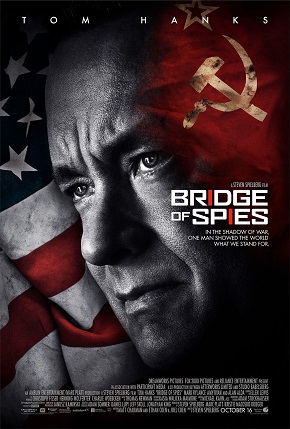

Grade: A-
Verdict: Even though it isn’t among Spielberg’s most memorable, “Bridge of Spies” is still a good film, well directed and acted, especially if you enjoy the history of the Cold War.
The film “Bridge of Spies” is not one of Steven Spielberg’s epic triumphs. In this Cold War drama, things are more subtle and quiet. Characters don’t go into the field of battle, but instead deal with their own mission in a world divided by two ideologies. It is an interesting approach by one iconic filmmaker, known for his expansive scenes and their dramatic scores, because it escapes normality in his body of work.
This is the true story of James Donovan (Tom Hanks), an American insurance agent with a background in criminal justice. The CIA recruits him to defend Rudolf (Mark Rylance), a Soviet spy captured in Brooklyn. The United States want to condemn Rudolf to execution, but our government decides to give him a “fair trial” in order to show the world that the right justice applies to everyone, even enemies. However, James decides to appeal the case, going against his boss, his family and the whole country.
The opening of the film captures this world of spying well and draws us in without too many words. Rudolf is first seen painting. When leaving his apartment, someone follows him. The camera here is shaky as we ride the bus and train of New York, just as if we, the audience, were playing the game of spying. We see Rudolf from the point of view of those following him, even though these characters are not even on screen yet. These choices are effective as they bring the thrill of spying right away.
The rest of the film concentrates on James getting to know Rudolf, and his attempts to defend him. The trial scenes are short and come quickly. Spielberg saves us from the classic structure of waiting for the very last trial, which is a relief. He focuses instead on how these two men form a bond, and how James plays a role in negotiating the exchange of Rudolf for two Americans held prisoners by East Germany and the Soviet Union.
Tom Hanks and Mark Rylance work well together. One of the drawbacks of the film is that it does not explore more of their growing friendship. There are great scenes, though, such as when Rudolf tells James how he reminds him of a childhood figure his father used to say: “pay close attention to this man.” Rudolf says this man never gave in, even under pressure. He always bounced back and stood up again. It is a beautiful metaphor that’s brought back as the film ends: one of the most memorable details in the movie.
The images of “Bridge of Spies” have a cold, blue tone that’s extremely appropriate to the film. It’s a world filled with troubles. A world with few and sad colors. This choice is accompanied by a superb camera work, exemplified by when Spielberg takes us to East Berlin: the wide shots show us a city in total chaos, while the few close ups on James show us his fear and anxiety.
Speaking of which, dialogue is mostly to the point. It is great to see the irony of the Coen brothers, Joel and Ethan, two of the three screenwriters, sneak in here at some moments. The moments are rare, however, as Spielberg’s style is commercial, while Joel and Ethan are at their best with the cult mood of their own films.
“Bridge of Spies” does many things right, but it fails at being memorable. It is a film where good and bad are already so well defined that there’s little room to play in that grey area between both of them in order to raise tension and suspense about the characters. It is a fine movie, but not one that necessarily needs to be in your Spielberg collection.
